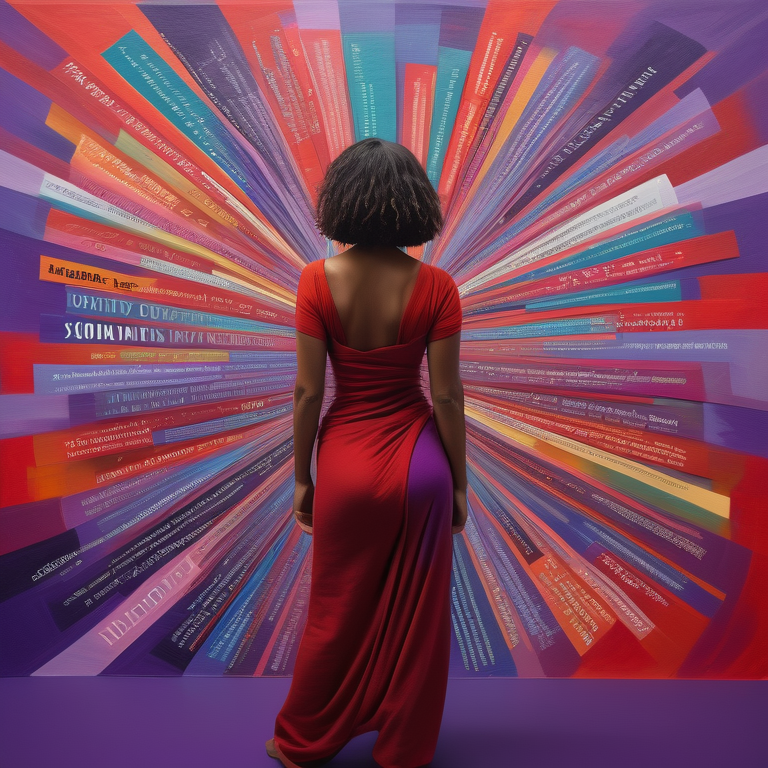Female Sexuality in Contemporary Fiction

Key Highlights
- The evolution of female sexuality in fiction has reflected societal changes and the empowerment of women.
- Contemporary narratives focus on themes of consent, agency, and the role of fantasy and desire in shaping female characters.
- LGBTQ+ women are now being represented more inclusively in fiction, breaking stereotypes and expanding the conversation around sexuality.
- Feminism has had a significant impact on female sexuality in literature, empowering heroines and exploring the intersectionality of sexuality.
- Controversies and criticisms surround the portrayal of female sexuality in literature, particularly regarding the fine line between liberation and objectification.
- Emerging authors and influential works in the realm of erotic fiction are shaping the genre and challenging societal norms.
- Digital platforms and social media are playing a crucial role in the representation and engagement of readers with female sexuality in literature.
Introduction
Female sexuality has been a prominent and evolving theme in literature throughout history. In contemporary fiction, female writers have boldly explored the complexities of female desire, intimacy, and sexual agency. This blog will delve into the evolution of female sexuality in fiction, analyze modern themes in female sexuality, discuss the representation of LGBTQ+ women in fiction, examine the impact of feminism on female sexuality in literature, explore controversies and criticisms in the portrayal of female sexuality, highlight emerging authors and influential works, and discuss the role of digital platforms and social media in shaping female sexuality in literature.
The Evolution of Female Sexuality in Fiction
Female sexuality in fiction has evolved alongside societal changes and the increasing empowerment of women. In earlier centuries, ideas regarding female sexuality were restricted and taboo, often viewed as deviant. However, the sexual revolution of the 1920s marked a shift towards greater sexual freedom and acceptance. Female writers have played a crucial role in exploring and challenging the traditional portrayal of women’s sexuality in English literature.
From Taboo to Mainstream: A Historical Overview
In the past, women’s sexuality in literature was often treated as a taboo subject. Female desire and sexual liberation were viewed as threats to societal norms and morality. However, over time, women’s sexuality has moved from the fringes to the mainstream of literature. Female writers have pushed boundaries, challenging the traditional portrayal of women as passive objects of desire and exploring the complexities of female sexuality in more nuanced and realistic ways.
Key Milestones in Women’s Erotic Literature
Women’s erotic literature has played a significant role in shaping the representation of female sexuality. Throughout history, there have been key milestones in this genre that have challenged societal norms and provided a platform for female sexual desire. From Anais Nin’s groundbreaking work in the early 20th century to modern authors like E.L. James, women have been at the forefront of exploring and expressing their own sexual desires through literature. These works have not only empowered women to embrace their sexuality but have also opened up conversations about female desire and pleasure.
Analyzing Modern Themes in Female Sexuality
Contemporary fiction explores a range of themes related to female sexuality. Female characters are portrayed with agency and complexity, and their sexual desires and experiences are given equal weight to those of male characters. Intimacy and the exploration of sexual desire are central to these narratives, emphasizing the importance of consent and the role of fantasy and desire in shaping characters’ experiences.
Consent and Agency: Central Pillars of Contemporary Narratives
In modern fiction, consent and agency are central to the portrayal of female sexuality. Female protagonists are empowered to make their own choices and assert their desires, challenging traditional gender roles. They navigate complex relationships and negotiate consent, highlighting the importance of open communication and mutual respect. Some key aspects of contemporary narratives include:
- Emphasis on enthusiastic consent in sexual encounters
- Exploration of power dynamics and the importance of agency
- Portrayal of women taking control of their own sexual experiences
- Representation of diverse sexual preferences and identities
The Role of Fantasy and Desire in Shaping Characters
Fantasy and desire play a significant role in shaping female characters in contemporary fiction. These elements provide a window into their innermost thoughts and desires, allowing readers to connect with their experiences on a deeper level. Female characters explore their fantasies and desires, challenging societal expectations and breaking free from traditional gender roles. By embracing their sexual desires, these characters assert their agency and assert their own identities.
Representation of LGBTQ+ Women in Fiction
Representation of LGBTQ+ women in fiction has become more inclusive and diverse in recent years. Authors are exploring a wide range of sexual orientations and gender identities, challenging stereotypes and promoting inclusivity. By incorporating LGBTQ+ characters into their narratives, female writers are creating more realistic and representative portrayals of the diverse experiences and identities of women across the spectrum of sexuality.
Breaking Stereotypes: Diverse Sexual Identities
Contemporary fiction is breaking stereotypes by portraying diverse sexual identities among LGBTQ+ women. Authors are challenging the notion that there is a single narrative or experience for LGBTQ+ individuals. By embracing a range of identities, from lesbian to bisexual to transgender, these narratives highlight the diversity within the LGBTQ+ community and promote greater understanding and acceptance. These stories give voice to characters who have historically been marginalized or underrepresented, creating more inclusive and authentic representations of sexuality in literature.
Challenges and Triumphs in LGBTQ+ Storytelling
The portrayal of LGBTQ+ women in fiction has faced both challenges and triumphs. While there has been progress in representation, there are still hurdles to overcome. Some key challenges include:
- Overcoming stereotypes and ensuring authentic representation
- Navigating societal backlash and discrimination
- Balancing the need for positive representation with realistic storytelling
Despite these challenges, LGBTQ+ storytelling has also seen significant triumphs. Some examples include:
|
Title |
Author |
Year |
|
“Stone Butch Blues” |
Leslie Feinberg |
1993 |
|
“Hood” |
Emma Donoghue |
1995 |
|
“Middlesex” |
Jeffrey Eugenides |
2002 |
|
“The Color Purple” |
Alice Walker |
1982 |
These works have made significant contributions to LGBTQ+ storytelling, challenging societal norms and promoting greater understanding and acceptance.
The Impact of Feminism on Female Sexuality in Literature
Feminism has had a profound impact on female sexuality in literature. It has challenged traditional gender roles and provided a platform for female voices and experiences. Female writers have embraced feminist principles, exploring and celebrating female sexuality in ways that empower women and challenge societal norms. Through their narratives, they have paved the way for more honest and inclusive discussions about female desire, pleasure, and agency.
Empowerment through Narrative: A New Era of Heroines
Contemporary literature showcases a new era of heroines who are empowered through their narratives. These characters defy societal expectations and take control of their own lives and desires. Their stories promote female empowerment, encouraging readers to embrace their own sexuality and challenge societal norms. By centering the experiences and perspectives of strong and independent female characters, these narratives provide a platform for women’s voices and experiences to be heard and celebrated.
Intersectionality and Sexuality: Expanding the Conversation
Intersectionality plays an important role in the exploration of female sexuality in literature. It highlights the interconnectedness of different aspects of a person’s identity, such as race, class, and sexuality, and how these intersecting identities shape their experiences. Intersectional narratives challenge the dominant narratives of female sexuality and provide a more nuanced and inclusive understanding of sexual experiences. By exploring the complexities and intersections of identity, these narratives expand the conversation around female sexuality and promote greater understanding and empathy.
Controversies and Criticisms in Portraying Female Sexuality
The portrayal of female sexuality in literature has sparked controversies and criticisms over the years. Society’s discomfort with female desire and the objectification of women have been major points of contention. Critics argue that the fine line between liberation and objectification is often blurred, leading to harmful stereotypes and unrealistic expectations. It is important to consider these criticisms and strive for authentic, nuanced portrayals of female sexuality in literature.
The Fine Line between Liberation and Objectification
The portrayal of female sexuality in literature often walks a fine line between liberation and objectification. While it is essential to celebrate female desire and agency, it is equally crucial to avoid reducing women to mere objects of desire. Authentic portrayals of female sexuality should emphasize the complexity and diversity of women’s experiences, highlighting their agency and empowerment. By avoiding harmful stereotypes and unrealistic expectations, authors can navigate the fine line between liberation and objectification and create more nuanced and respectful representations of female sexuality.
Reader and Critic Reactions to Explicit Content
The inclusion of explicit content in literature depicting female sexuality has elicited various reactions from readers and critics. While some argue that explicit content is necessary to accurately portray sexual experiences, others contend that it can be gratuitous and objectifying. Reader reactions to explicit content vary, with some finding it empowering and others finding it uncomfortable or offensive. Critics have also weighed in, with some praising the realism and authenticity it brings to the narrative, while others question its artistic merit. The inclusion of explicit content should be approached with sensitivity and a consideration for the overall impact on the narrative and its portrayal of female sexuality.
Emerging Authors and Influential Works
Emerging authors are making significant contributions to the genre of erotic fiction, shaping the representation of female sexuality. Their works challenge societal norms and provide fresh perspectives on desire, pleasure, and intimacy. These authors are pushing boundaries and expanding the genre to include diverse voices and experiences. Some notable emerging authors and influential works in the realm of erotic fiction include:
- “The Pisces” by Melissa Broder
- “Her Body and Other Parties” by Carmen Maria Machado
- “The Sexual Life of Catherine M.” by Catherine Millet
- “Wetlands” by Charlotte Roche
These works have garnered critical acclaim and sparked important conversations about female sexuality, establishing their place in the literary landscape.
Rising Stars in the Realm of Erotic Fiction
Female writers are rising stars in the realm of erotic fiction, challenging societal norms and pushing the boundaries of sexual representation. These writers explore the complexities of desire, pleasure, and intimacy, crafting compelling narratives that resonate with readers. Some notable rising stars in the realm of erotic fiction include:
- Tamsin Flowers
- Tiffany Reisz
- Megan Hart
- Selena Kitt
These authors bring fresh perspectives and diverse voices to the genre, creating stories that celebrate female sexuality and provide engaging and empowering narratives for readers.
Must-Read Books That Shaped the Genre
Several must-read books have shaped the genre of female sexuality in literature. These influential works have broken new ground and challenged societal norms, providing a platform for the exploration and celebration of female desire. Some must-read books that have shaped the genre of female sexuality include:
- “Delta of Venus” by Anaïs Nin
- “Fear of Flying” by Erica Jong
- “The Story of O” by Pauline Réage
- “Little Birds” by Anaïs Nin
These works have had a lasting impact on the representation of female sexuality in literature, paving the way for more inclusive and nuanced narratives.
The Role of Digital Platforms and Social Media
Digital platforms and social media have revolutionized the way readers engage with literature and female sexuality. These platforms provide a space for discussions, recommendations, and exploration of diverse narratives. Online communities have emerged, where readers can connect with like-minded individuals and share their thoughts on feminist erotica and female sexuality. Social media platforms, such as Facebook and Instagram, also play a crucial role in promoting and disseminating feminist erotica, allowing readers to discover new works and engage with authors.
Online Communities and the Sharing of Feminist Erotica
Online communities have provided a safe and inclusive space for the sharing and discussion of feminist erotica. These communities bring together readers who are passionate about exploring and celebrating female sexuality in literature. Facebook groups, such as “Feminist Erotica Book Club” and “Erotic Reading Circle,” offer platforms for readers to connect, share recommendations, and engage in thoughtful discussions about feminist erotica. These communities have created a supportive environment for readers to discover new works, explore different perspectives, and celebrate the diversity of female desire.
How Digital Access Is Changing Reader Engagement
Digital access has transformed reader engagement with literature and female sexuality. E-books and digital platforms, such as Amazon Kindle, have made it easier for readers to access a wide range of feminist erotica and explore diverse narratives. Readers can now discover and download books with just a few clicks, allowing for greater accessibility and exposure to different perspectives. This digital accessibility has also opened up opportunities for self-published authors to reach a wider audience and share their stories of female sexuality. The ease of digital access has significantly contributed to the democratization of literature and empowered readers to explore and engage with female sexuality in new and exciting ways.
Conclusion
Female sexuality in contemporary fiction has undergone a remarkable evolution, from being taboo to now central in narratives. Modern themes focus on consent, agency, and diverse sexual identities, breaking stereotypes and empowering heroines. LGBTQ+ representation challenges norms, expanding the conversation on intersectionality. While controversies exist regarding objectification, reader engagement with explicit content sparks discussions. Emerging authors and influential works shape the genre, with digital platforms amplifying feminist erotica. As we celebrate rising stars and must-read books, it’s evident that digital access is transforming reader engagement. Share this enlightening exploration of female sexuality in fiction on social media to continue the conversation.
Frequently Asked Questions
What distinguishes contemporary female sexuality in fiction from the past?
Contemporary female sexuality in fiction differs from the past in its portrayal of women as empowered, complex, and multi-dimensional characters. It challenges traditional gender roles and explores diverse perspectives, reflecting the societal changes and evolving understanding of female desire.
How do authors navigate the balance between empowerment and objectification?
Authors navigate the balance between empowerment and objectification by portraying female characters as fully developed individuals with agency and complex desires. They avoid reducing women to mere objects of desire and instead emphasize their empowerment and the importance of consent and agency in their sexual experiences.
Can erotic fiction contribute to feminist discourse?
Yes, erotic fiction can contribute to feminist discourse by providing a platform for the exploration and celebration of female desire and agency. It challenges societal norms and promotes discussions about consent, pleasure, and the diversity of female sexuality.
Are digital platforms making a positive impact on the diversity of stories told?
Yes, digital platforms are making a positive impact on the diversity of stories told by providing a space for marginalized voices, including LGBTQ+ and women of color. These platforms allow for greater visibility and accessibility, promoting a more inclusive representation of female sexuality and experiences.





